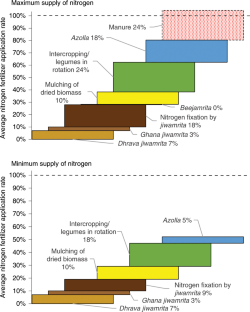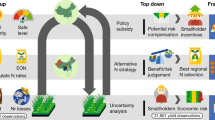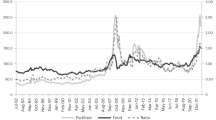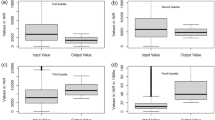Abstract
Under current trends, 60% of India’s population (>10% of people on Earth) will experience severe food deficiencies by 2050. Increased production is urgently needed, but high costs and volatile prices are driving farmers into debt. Zero budget natural farming (ZBNF) is a grassroots movement that aims to improve farm viability by reducing costs. In Andhra Pradesh alone, 523,000 farmers have converted 13% of productive agricultural area to ZBNF. However, sustainability of ZBNF is questioned because external nutrient inputs are limited, which could cause a crash in food production. Here, we show that ZBNF is likely to reduce soil degradation and could provide yield benefits for low-input farmers. Nitrogen fixation, either by free-living nitrogen fixers in soil or symbiotic nitrogen fixers in legumes, is likely to provide the major portion of nitrogen available to crops. However, even with maximum potential nitrogen fixation and release, only 52–80% of the national average nitrogen applied as fertilizer is expected to be supplied. Therefore, in higher-input systems, yield penalties are likely. Since biological fixation from the atmosphere is possible only with nitrogen, ZBNF could limit the supply of other nutrients. Further research is needed in higher-input systems to ensure that mass conversion to ZBNF does not limit India’s capacity to feed itself.
This is a preview of subscription content, access via your institution
Access options
Access Nature and 54 other Nature Portfolio journals
Get Nature+, our best-value online-access subscription
$29.99 / 30 days
cancel any time
Subscribe to this journal
Receive 12 digital issues and online access to articles
$119.00 per year
only $9.92 per issue
Buy this article
- Purchase on Springer Link
- Instant access to full article PDF
Prices may be subject to local taxes which are calculated during checkout

Similar content being viewed by others
Data availability
No datasets were generated or analysed during the current study. This is an analysis of existing data. All data were collated from literature sources as cited.
Code availability
The ORATOR model has been described and published previously (see Supplementary Information) and will be made available from the corresponding author on request.
References
Foley, J. A. et al. Solutions for a cultivated planet. Nature 478, 337–342 (2011).
India Population Live (Worldometers, 2019); https://www.worldometers.info/world-population/india-population/
World Population Prospects, the 2012 Revision (UN Department of Economic and Social Affairs, 2013); https://go.nature.com/37N2olc
Ritchie, H., Reay, D. & Higgins, P. Sustainable food security in India—domestic production and macronutrient availability. PLoS ONE 13, e0193766 (2018).
Bruinsma, J. (ed.) World Agriculture: Towards 2015/2030. An FAO Perspective (Earthscan, 2003).
Agoramoorthy, G. Can India meet the increasing food demand by 2020? Futures 40, 503–506 (2008).
Smith, P. Delivering food security without increasing pressure on land. Glob. Food Secur. 2, 18–23 (2013).
Ray, D. K. et al. Climate change has likely already affected global food production. PLoS ONE 14, e0217148 (2019).
Bhattacharyya, R. et al. Soil degradation in India: challenges and potential solutions. Sustainability 7, 3528–3570 (2015).
Mythili, G. & Goedecke, J. in Economics of Land Degradation and Improvement—A Global Assessment for Sustainable Development (eds Nkonya, E. et al.) 431–469 (Springer, 2016); https://go.nature.com/2FERCkZ
United Nations Decade of Family Farming 2019–2028. Global Action Plan (FAO and IFAD, 2019); https://reliefweb.int/sites/reliefweb.int/files/resources/ca4672en.pdf
52 Profiles on Agroecology: Zero Budget Natural Farming in India (FAO, 2019); http://www.fao.org/3/a-bl990e.pdf
Govt. should stop promoting zero budget natural farming pending proof: scientists. The Hindu (11 September 2019); https://go.nature.com/2FrKSH1
Sitharaman, N. Budget 2019–2020 speech. India Ministry of Finance (5 July 2019); https://www.indiabudget.gov.in/budgetspeech.php
Sanhati Collective Farmer Suicides in India: A Policy-induced Disaster of Epic Proportions http://sanhati.com/excerpted/4504/ (2012).
Patel, V. et al. Suicide mortality in India: a nationally representative survey. Lancet 379, 2343–2351 (2012).
Kennedy, J. & King, L. The political economy of farmers’ suicides in India: indebted cash-crop farmers with marginal landholdings explain state-level variation in suicide rates. Glob. Health 10, 16 (2014).
Abhilash, P. C. & Singh, N. Pesticide use and application: an Indian scenario. J. Hazard. Mater. 165, 1–12 (2009).
Kumari, S. & Sharma, H. The impact of pesticides on farmer’s health: a case study of fruit bowl of Himachal Pradesh. Int. J. Sci. Res. 3, 144–148 (2012).
Zero Budget Natural Farming http://apzbnf.in (RySS, Government of Andhra Pradesh, 2018).
Khadse, A. & Rosset, P. M. Zero budget natural farming in India—from inception to institutionalization. Agroecol. Sust. Food 43, 848–871 (2019).
Statistical Abstract Andhra Pradesh 2015 (Directorate of Economics and Statistics, Government of Andhra Pradesh, 2016); https://desap.cgg.gov.in/jsp/website/gallery/Statistical%20Abstract%202015.pdf
RySS Zero Budget Natural Farming as A Nature-based Solution for Climate Action (UNEP, 2019); https://wedocs.unep.org/handle/20.500.11822/28895?show=full
Report of the Global Environment Facility to the Fourteenth Session of the Conference of the Parties to the United Nations Convention to Combat Desertification (GEF, 2019); https://go.nature.com/2tzvntM
Patra, A. M. Accounting methane and nitrous oxide emissions, and carbon footprints of livestock food products in different states of India. J. Clean. Prod. 162, 678–686 (2017).
Kumar, V. India—innovations in agroecology. Engineering transformation through zero budget natural farming (ZBNF). In Scaling Up Agroecology to Achieve the Sustainable Development Goals. Proc. 2nd FAO International Symposium 250–251 (FAO, 2019) http://www.fao.org/3/BU710EN/bu710en.pdf
Palekar, S. Zero Budget Spiritual Farming http://palekarzerobudgetspiritualfarming.org (2019).
Ram, R. A., Singha, A. & Vaish, S. Microbial characterization of on-farm produced bio-enhancers used in organic farming. Indian J. Agr. Sci. 88, 35–40 (2018).
App, A. A. et al. Nonsymbiotic nitrogen fixation associated with the rice plant in flooded soils. Soil Sci. 130, 283–289 (1980).
Sreenivasa, M. N., Naik, N. & Bhat, S. N. Beejamrutha: a source for beneficial bacteria. Karnataka J. Agric. Sci. 22, 1038–1040 (2009).
Rao, S. C. & Dao, T. H. Fertilizer placement and tillage effects of nitrogen assimilation by wheat. Agron. J. 84, 1028–1032 (1992).
Erenstein, O. & Laxmi, V. Zero tillage impacts in India’s rice–wheat systems: a review. Soil Till. Res. 100, 1–14 (2008).
Singh, A., Phogat, V. K., Dahiya, R. & Batra, S. D. Impact of long-term zero till wheat on soil physical properties and wheat productivity under rice–wheat cropping system. Soil Till. Res. 140, 98–105 (2014).
Ram, A. R. Innovations in organic production of fruits and vegetables. Shodh Chintan 11, 85–98 (2019).
National Crop Statistics (FAOSTAT, 2019); http://www.fao.org/faostat/en/#data/QC
Fertilizer Use by Crop in India (FAO, 2005); http://www.fao.org/tempref/agl/agll/docs/fertuseindia.pdf
Hamshere, P., Sheng, Y., Moir, B., Gunning-Trant, C. & Mobsby, D. What India Wants: Analysis of India’s Food Demand to 2050 Report No. 14.16 (ABARES, 2014); http://agriculture.gov.au/abares/publications
Montanarella, L., Scholes, R. & Brainich, A. (eds) The IPBES Assessment Report on Land Degradation and Restoration (IPBES, 2018); www.ipbes.net
Hati, K. M., Swarup, A., Dwivedi, A. K., Misra, A. K. & Bandyopadhyay, K. K. Changes in soil physical properties and organic carbon status at the topsoil horizon of a vertisol of central India after 28 years of continuous cropping, fertilization and manuring. Agr. Ecosyst. Environ. 119, 127–134 (2006).
Smith, J. et al. Treatment of organic resources before soil incorporation in semi-arid regions improves resilience to El Niño, and increases crop production and economic returns. Environ. Res. Lett. 14, 085004 (2019).
Guidelines for Sustainable Manure Management in Asian Livestock Production Systems IAEA-TECDOC-1582 (IAEA, 2008); https://www-pub.iaea.org/MTCD/Publications/PDF/TE_1582_web.pdf
Bradbury, N. J., Whitmore, A. P., Hart, P. B. S. & Jenkinson, D. S. Modelling the fate of nitrogen in crop and soil in the years following application of 15N-labelled fertilizer to winter wheat. J. Agric. Sci. 121, 363–379 (1993).
Lal, R. Soil carbon sequestration in India. Climatic Change 65, 277–296 (2004).
FAO World Development Indicators. Agricultural Land (% of Land Area)—India (World Bank, 2019); https://data.worldbank.org/indicator/AG.LND.AGRI.ZS?locations=IN
Aggarwal, G. C. & Singh, N. T. Energy and economic returns from cattle dung manure as fuel. Energy 9, 87–90 (1984).
Saxena, K. L. & Sewak, R. Livestock waste and its impact on human health. Int. J. Agric. Sci. 6, 1084–1099 (2016).
Acknowledgements
We thank V. Kumar, Z. Hussain and R. Nalavade of RySS for information, support while visiting sites and discussions. Funding for this work was provided by the Newton Bhabha Virtual Centre on Nitrogen Efficiency in Whole Cropping Systems (NEWS) project no. NEC 05724, the DFID-NERC El Niño programme in project NE P004830, ‘Building Resilience in Ethiopia’s Awassa Region to Drought’ (BREAD), the ESRC NEXUS programme in project IEAS/POO2501/1, ‘Improving Organic Resource Use in Rural Ethiopia’ (IPORE), and the GCRF South Asian Nitrogen Hub (NE/S009019/1). J.Y. was supported by the Scottish Government’s Rural and Environment Research and Analysis Directorate under the current Strategic Research Programme (2016–2021): Research Deliverable 1.1.3: Soils and Greenhouse Gas Emissions. The input of P.S. contributes to the UKRI-funded projects DEVIL (NE/M021327/1), Soils-R-GRREAT (NE/P019455/1) and N-Circle (BB/N013484/1), the European Union’s Horizon 2020 Research and Innovation Programme projects CIRCASA (grant agreement no. 774378) and UNISECO (grant agreement no. 773901), and the Wellcome Trust-funded project Sustainable and Healthy Food Systems (SHEFS).
Author information
Authors and Affiliations
Contributions
J.S. was primarily responsible for the conception and design of the work, the acquisition, analysis and interpretation of data and the drafting of the manuscript. J.Y., P.S. and D.R.N. contributed towards the conception and design of the work and revision of the manuscript. D.R.N. also contributed to the creation of software used in the work.
Corresponding author
Ethics declarations
Competing interests
The authors declare no competing interests.
Additional information
Publisher’s note Springer Nature remains neutral with regard to jurisdictional claims in published maps and institutional affiliations.
Supplementary information
Supplementary Information
Supplementary notes 1–8, Tables 1–9, Figs. 1 and 2 and refs. 1–147.
Rights and permissions
About this article
Cite this article
Smith, J., Yeluripati, J., Smith, P. et al. Potential yield challenges to scale-up of zero budget natural farming. Nat Sustain 3, 247–252 (2020). https://doi.org/10.1038/s41893-019-0469-x
Received:
Accepted:
Published:
Issue Date:
DOI: https://doi.org/10.1038/s41893-019-0469-x
This article is cited by
-
Microbial interactions shape cheese flavour formation
Nature Communications (2023)
-
Shaping a resilient future in response to COVID-19
Nature Sustainability (2023)
-
Natural farming improves crop yield in SE India when compared to conventional or organic systems by enhancing soil quality
Agronomy for Sustainable Development (2023)
-
Sustainable options for fertilizer management in agriculture to prevent water contamination: a review
Environment, Development and Sustainability (2023)
-
Microbiological properties of Beejamrit, an ancient Indian traditional knowledge, uncover a dynamic plant beneficial microbial network
World Journal of Microbiology and Biotechnology (2022)



